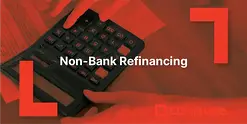When the Bank Says No: 5 Real-Life Scenarios Where Non-Bank Lending Works
 By
Trent Bradley
·
4 minute read
By
Trent Bradley
·
4 minute read

For many borrowers, the assumption is that banks are the only path to finance. But traditional banks operate with strict criteria that don’t always match real-life circumstances. That’s where non-bank lenders step in—not as a “last resort,” but as a flexible, practical solution. Here are five case studies showing when non-bank lending makes sense.
Key Takeaways
- Non-bank lenders assess self-employed income using bank statements and tax records instead of traditional payslips, solving documentation issues banks reject
- Property investors blocked by bank portfolio limits can access non-bank finance that evaluates rental income and total asset strength differently
- A single credit blemish or missed payment won't automatically disqualify you—non-bank lenders assess overall repayment capacity beyond credit scores
- Bridging finance from non-bank lenders processes faster than banks, enabling timely property purchases before your current home sells
- Overseas income in foreign currencies qualifies with non-bank lenders who verify international earnings, bypassing restrictive bank policies
- Non-bank lending isn't a last resort—it's a strategic solution for legitimate borrowers whose circumstances don't fit rigid bank criteria
1. The Self-Employed Borrower
Case: A small business owner with solid income but inconsistent pay slips applied for a home loan. The bank rejected the application due to “irregular documentation.”
Non-Bank Solution: A non-bank lender assessed the business’s true earning capacity using bank statements and tax records instead of traditional payslips. The borrower secured funding and kept the business growing.
2. The Property Investor with Multiple Loans
Case: An experienced investor owned five properties. When applying for the next purchase, their bank declined because their existing portfolio pushed them over internal lending limits.
Non-Bank Solution: A non-bank lender evaluated the investor’s full portfolio differently, recognizing rental income and asset strength. The deal was approved, allowing the investor to expand strategically.
3. The Borrower with a Recent Credit Issue
Case: A professional had one missed payment that affected their credit score. Despite a strong financial position, the bank declined the loan on this technicality.
Non-Bank Solution: Non-bank lenders looked beyond the blemish, focusing on the borrower’s overall capacity to repay. The finance went through, and the borrower refinanced later once their credit was repaired.
4. Bridging Finance for a Timely Purchase
Case: A family found their dream home before their current property sold. Their bank couldn’t process a bridging loan quickly enough to meet the purchase deadline.
Non-Bank Solution: A non-bank lender provided short-term bridging finance, enabling the family to secure the new home without stress. Once their old property sold, the loan was refinanced smoothly.
5. Borrowers with Overseas Income
Case: An expat with income in a foreign currency applied for a loan in Australia. The bank rejected the application due to “policy restrictions.”
Non-Bank Solution: A non-bank lender accepted verified overseas income and adjusted the assessment fairly. The borrower accessed property finance without unnecessary barriers.
Conclusion
These scenarios highlight a simple truth: life doesn’t always fit neatly into bank tick-boxes. Non-bank lending isn’t about desperation—it’s about flexibility, speed, and understanding real financial stories. Whether you’re self-employed, growing a portfolio, or navigating unique income situations, non-bank solutions may be the right fit when the bank says no.
Frequently Asked Questions
What's the main difference between banks and non-bank lenders?
Non-bank lenders are financial institutions that provide mortgages without holding banking licenses. They assess applications with more flexibility, focusing on your actual ability to repay rather than rigid criteria. While banks must follow strict Reserve Bank LVR restrictions and standardized policies, non-bank lenders evaluate each situation individually, considering factors like business bank statements, rental portfolio performance, and verified overseas income that banks often reject.
Are non-bank lenders more expensive than banks?
Yes, non-bank lenders typically charge higher interest rates (7.5-10.5%) compared to banks (6.0-7.5%), and establishment fees run $1,500-$3,000 versus banks' $500-$1,000. However, many borrowers use non-bank finance strategically as a 2-3 year bridge solution—accessing property now, building equity, then refinancing to a traditional bank once their circumstances improve. The premium cost provides immediate market entry rather than waiting years while prices potentially rise.
Will a past credit issue permanently disqualify me from getting finance?
Not with non-bank lenders. While banks often auto-decline applications with any credit blemishes, non-bank lenders assess the full picture—considering when the issue occurred, whether it's resolved, and your current financial position. A single missed payment or old default won't necessarily block your application if you demonstrate strong repayment capacity now. Once you've maintained good repayment history for 12-24 months, you can typically refinance to a bank at lower rates.
How quickly can non-bank lenders approve bridging finance?
Non-bank lenders typically process bridging finance in 1-3 weeks, sometimes faster for urgent situations. This speed advantage proves critical when you've found your next property but haven't sold your current home yet. Banks often can't meet tight settlement deadlines due to lengthy approval processes. Non-bank bridging finance lets you secure the purchase immediately, then refinance to standard lending once your original property sells.
Can I get a home loan with overseas income?
Yes, non-bank lenders accept verified overseas income in foreign currencies, while most banks have policy restrictions that automatically decline these applications. You'll need to provide documentation proving consistent foreign income (employment contracts, tax returns, bank statements), and the lender will assess currency stability and conversion rates. This solution works particularly well for expats, contractors with international clients, or business owners with offshore revenue streams.
Do non-bank lenders have the same consumer protections as banks?
Absolutely. Non-bank lenders must comply with identical regulations including the Credit Contracts and Consumer Finance Act (CCCFA) responsible lending requirements, Financial Markets Conduct Act, Privacy Act, and Fair Trading Act. You receive the same legal protections regardless of whether you borrow from a bank or non-bank lender. All lenders must assess your ability to repay without hardship and provide clear disclosure of all terms and fees.

Trent Bradley
Trent Bradley is a New Zealand financial advisor specializing in property-backed finance and investment consulting. With over 26 years of experience running his mortgage broking business, he has helped wholesale investors access high-yield property-backed loan opportunities. For the past 12 years, Trent has led Luminate Finance, a New Zealand finance company dedicated to connecting investors with secure property investment solutions.








